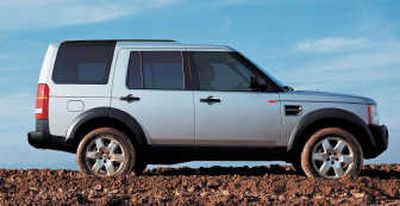LR3 a fantasy come true

Old-school SUV design is as dead as the empire that birthed it.
Back when the sun never set on the Union Jack and it was always tea-time somewhere, the computer-mediated 2007 Land Rover LR3 might have seemed like a fantasy out of the mind of H.G. Wells.
These days, it is as inevitable as an Oxford don’s tweed jacket.
In 2004, the LR3 replaced the Discovery, a midsize remnant of truck-based SUV design. It occupies a ripe middle ground between crossover-utility-vehicle and full-on sport-ute and is as comfortable on I-90 as it is capable on the Serengeti.
Sadly, I can vouch only for the former.
On the outside, the LR3 employs a modern take on traditional SUV styling. On the inside, it marries the gravitas of a serious off-roader with the comforts, if not the opulence, of a luxury SUV.
Down below, where the heavy lifting is done, Land Rover substitutes computerized systems for traditional SUV mechanicals.
The LR3 is available in six-cylinder (from $42,150, including destination) and eight-cylinder ($48,950) iterations and competes against such rigs as the BMW X5, the Mercedes-Benz GL Class, the Lexus GS 470 and the Audi Q7.
Harnessing Electrons
When designing the LR3, engineers rejected both the body-on-frame construction of traditional SUVs and the car-based unibody of the crossover class.
Instead, they integrated a hydroformed steel-ladder frame into the body shell, forming a kind of structural hybrid. The resulting rigidity allowed them to replace the solid rear axle typical of SUV design with an independent rear air suspension, improving ride and handling.
Having jettisoned two of the key elements of SUV design, engineers fell back on a software solution.
Land Rover’s Terrain Response System (TRS) automatically adjusts an array of electronically controlled systems in response to driving conditions. Using a knob positioned on the center console, the driver can dial up settings for normal conditions, grass, gravel and snow, mud and ruts, sand, and rocks.
In response, TRS alters throttle response, the shift algorithms, the timing of the pulses made by the anti-lock brakes, the traction and stability control systems and the locking action of the differentials.
Another software solution, called “active roll mitigation,” is programmed into the air suspension to minimize body lean during corners and the hairier moments on the trail.
Even with roll mitigation and its height-adjustable air suspension, though, the LR3 is more prone to high-speed lean than more sport-oriented competitors.
Still an SUV
To further differentiate the LR3 from pavement-oriented “soft utes,” Land Rover added a two-speed transfer case and locking center differential. A locking rear diff is available.
The four-wheel-drive system can be engaged permanently or “on-the-fly.” The anti-lock braking system is calibrated to avoid wheel lock in all conditions and the hill-descent function limits forward speed downhill to 2.2 mph in low range and 3.7 mph in high range.
The rack-and-pinion steering system offers a compact, 37.6-foot turn circle for excellent maneuverability both off the road and in cramped parking lots.
Land Rover also engineers effective angles of approach, departure and break-over. The fragile stuff below is sheltered behind protective skid plates.
A Heavy Weight Contender
With its steel-frame construction, the lightest LR3 weighs in at 5,426 pounds. That’s enough to overwhelm the base, 216-horsepower V-6, although the six-speed automatic transmission does a yeoman’s job of compensating.
The eight makes 315 pound-feet of torque and has a towing capacity of 7,700 lbs.
Even when equipped with the 300-hp V-8, the LR3 accelerates purposefully, with the 0-60 sprint running at something more than 8 seconds. Two-lane passing requires care, even with an empty LR3, although once it gains momentum the rig is plenty fast.
Fortunately, the brakes are exceptional, offering sports-car-like stopping distances.
Land Rover specifies premium fuel for the V-8 and both engines manages fuel economy ratings of 14 city/19 highway.
Purposeful Comfort
In Range Rover fashion, the LR3’s interior is all business. Its leather-wrapped seats cry for a wood-paneled dash, or at least some chrome bits, but Land Rover went with functionality the whole way.
The rear doors are wide enough to allow graceful ingress and egress and the air suspension can be dropped to its lowest setting aid the cause. Seats are supportive and firm and a nine-speaker, six-disc, 440-watt harman/kardon audio system is standard. There are cupholders galore and bottle holders in the door panels. An optional cooler fits inside the console.
Even the third-row seats are habitable by adults, and come with extended curtain airbags. All rear seats may be folded down independently to increase cargo capacity to either 87.4 or 90.3, depending on the configuration.
It is said that to the uninitiated examples of advanced technology appear as magic. Land Rover’s early customers were among the planet’s most sophisticated denizens; still, the technologies that make the LR3 work would have looked to them like nothing less than the product of some powerful juju.
In a way they are, of course.